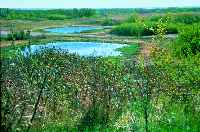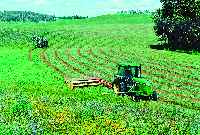| | Natural ecosystems are a vital component in sustaining ecological functions. They are essential for a healthy environment for plants, animals, and humans, as well as for human activities like agriculture (see Section 2.8). Conserving diverse ecosystems is the responsibility of everyone, including those in agriculture.
Food, water and cover are the three essential components of wildlife habitat. To retain and restore habitat, begin by taking stock of your farm. Consider the natural soil conditions and vegetation communities on the land before it was converted to agricultural use. Assess the different habitat types and consider what options would work best given your finances, management style and long-term goals. The options can be simple, like retaining existing treed areas or adding fall-seeded cereals to your crop rotation, or more involved, like planting natural areas to link existing habitat areas so animals can travel safely between these areas.
The following sections provide options for enhancing three main types of farm habitat: cropped land; non-cropped land; and wetland and riparian land.

Natural ecosystems are important in sustaining ecological functions.
Courtesy of DUC
Cropped Lands
Cropped lands can provide cover and food for ground-nesting birds and many small mammals. Practices that improve habitat also benefit soil, water and air quality.
BMPs to improve habitat on cropped land include:
- Convert lands that are marginally productive for annual crops into long-term forage production. This provides habitat for ground-nesting birds and small mammals.
- Add perennial or annual forages to your crop rotation to provide habitat for ground-nesting birds and small mammals. Manage perennial forage stands for longer life.
- When haying, use a flushing bar to flush out wildlife (see box).
- Delay haying near wetlands to reduce nesting losses for ground-nesting birds. Wait until at least July 1, and, whenever possible, delay until about mid-July, when nesting is usually near completion.
- Plant fall-seeded crops to improve habitat for ground-nesting birds.
- Reduce or eliminate tillage to minimize damage to nests and to increase the diversity of life in the soil (e.g. earthworms and mycorrhiza).
- Eliminate fall tillage to provide some cover and food during the winter.
- Rather than using conventional fallow, use strip cropping to provide some habitat.
- Use integrated pest management to minimize harm to non-target species.
Wildlife Flushing Bar - A flushing bar is an aluminum bar attached to the front of a tractor during haying operations. As the tractor moves along, chains or belts hanging down from the bar drag through the hay. The motion and noise scare ducks, songbirds, fawns and other wildlife out of the way of the equipment, saving their lives.

Flushing bar mounted on a tractor.
Courtesy of DUC
- For more information, contact your nearest Ducks Unlimited Canada office.
Back to Chapter 7 - Wildlife Habitat |
|